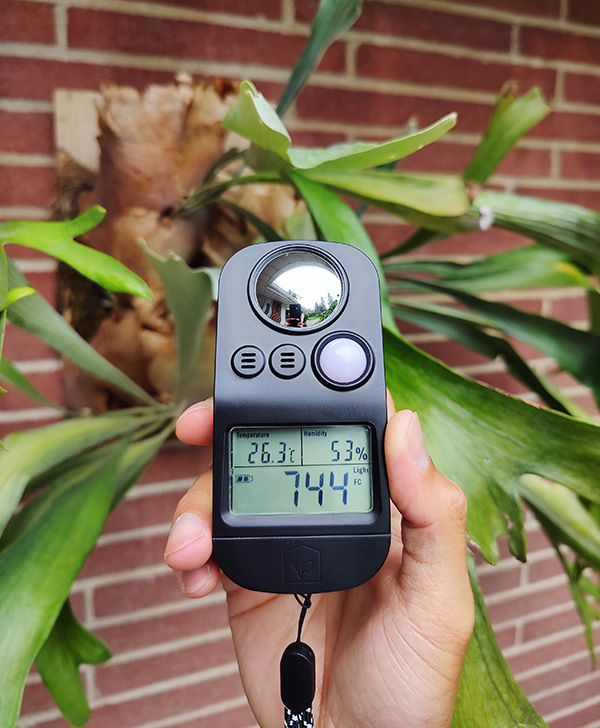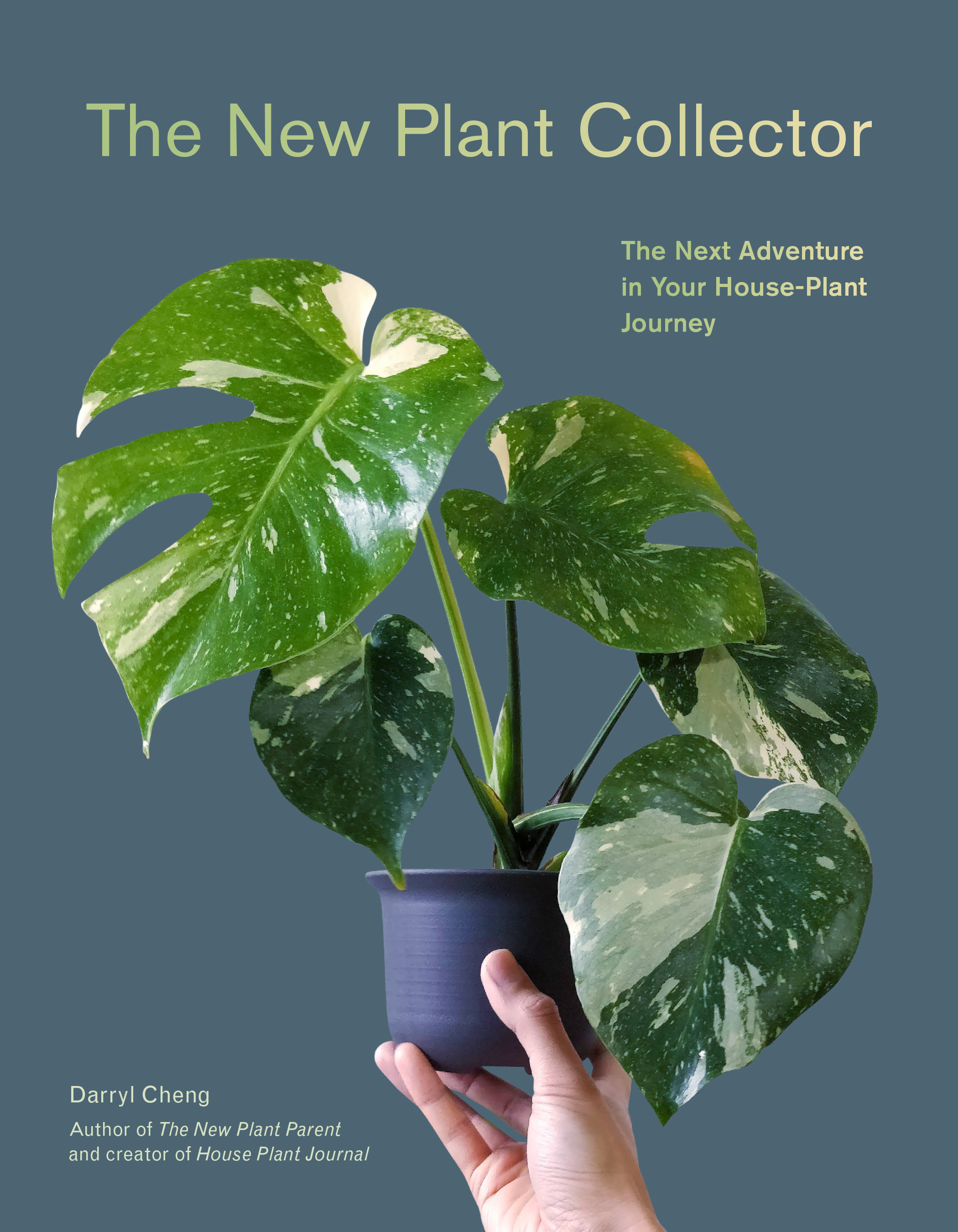Prerequisite: Light Meter
Without a light meter, you’ll never be able to make sense of how much light your plants are getting. It’s like buying an oven without knowing what temperature you’re setting it to; like a car with no speedometer.
A light meter is so critical to understanding light that I designed and manufactured my very own:
The LTH Meter
Light | Temperature | Humidity

I designed and manufactured the LTH Meter with houseplant owners in mind. When you know your light situation, you will know where to put plants (and where NOT to put plants) – and you can start using grow lights properly!
But any of these will do:
(Amazon Affiliate Links)
Dr. Meter (shown above): https://amzn.to/34qxtfx
Dr. Meter (version 2): https://amzn.to/2HE6F2A
URCERI Light Meter: https://amzn.to/3kvfcDr
Once you have a light meter, REFER TO THIS TABLE for grow light strength x duration recommendations by plant type.
Digging More Into the Details…
Q: What about PAR?
A: If you already have a PAR sensor, then you can use that and refer to the PPFD column instead of the foot-candles column. The conversion factor of 0.17 is applicable for most ***WHITE LED*** grow lights – I verified with my spectrometer! This conversion will not work for pure blue/red LED grow lights – and since they have no real advantage over white LED grow lights, just get the white ones.
White LED Grow Light
Foot-Candle to PPFD conversion factor: 0.17
How to use this chart:
1) Turn on your grow light.
2) Using a light meter, take a reading from the top of the plant (in foot-candles or in PPFD).
3) Cross reference with duration (in hours) to get the desired DLI.
Q: Wait – what is DLI?
A: It stands for Daily Light Integral and is a measure of how much light is received in a 24 hour period. More details HERE and HERE
| Intensity | Duration | ||||||
|---|---|---|---|---|---|---|---|
| Foot-Candles | PPFD (approx.) | 1 h | 2 h | 4 h | 8 h | 12 h | 16 h |
| 50 | 8.5 | 0.0306 | 0.06 | 0.1 | 0.2 | 0.4 | 0.5 |
| 100 | 17 | 0.0612 | 0.12 | 0.2 | 0.5 | 0.7 | 1.0 |
| 200 | 34 | 0.1224 | 0.24 | 0.5 | 1.0 | 1.5 | 2.0 |
| 400 | 68 | 0.2448 | 0.49 | 1.0 | 2.0 | 2.9 | 3.9 |
| 600 | 102 | 0.3672 | 0.73 | 1.5 | 2.9 | 4.4 | 5.9 |
| 800 | 136 | 0.4896 | 0.98 | 2.0 | 3.9 | 5.9 | 7.8 |
| 1000 | 170 | 0.6120 | 1.22 | 2.4 | 4.9 | 7.3 | 9.8 |
| 1500 | 255 | 0.9180 | 1.84 | 3.7 | 7.3 | 11.0 | 14.7 |
| 2000 | 340 | 1.2240 | 2.45 | 4.9 | 9.8 | 14.7 | 19.6 |
Q: That’s great but where do I find desired DLI for my plant?
A: Before I give you an answer, you must understand the concept of ***being precise but not prescriptive***. Calculating the DLI from your grow light is being *more precise* about light than not measuring at all or thinking “medium light” has any concrete meaning. But plants can grow in a wide range of DLI – it’s not as if the plant will surely die if the DLI is off by 0.1 mol/d. There’s also the issue of personal opinion, as in, whether you think the plant still looks nice. So even if you measure light precisely, it should not be taken as a prescription to guarantee perfect plants.
I’m working on my own set of values for different plants based on observations from *INDOOR* environments but here’s some documented values for *GREENHOUSE* production – and remember that “Minimum acceptable quality” is for commercial production of the plant. For recreational maintenance, the bar is lower, which is great news for us houseplant enthusiasts.
DLI for commercial greenhouse production of various plants: Purdue University: Commercial Greenhouse Production
Here are some grow lights that have worked well for my houseplants: FULL ARTICLE HERE
Here’s a very powerful grow light, capable of a DLI of over 20 mol/day: FULL ARTICLE HERE
Comparing With Natural Light Sources
Just for some context, here are a few measurements from natural light sources and situations. One CRITICAL thing to note: natural light is dynamic – meaning it changes throughout the day. So the actual DLI for any one day can vary a lot whereas, for grow lights, it’s a simple matter of multiplying the hourly PPFD by the number of hours the light is on.
Clear Sky – Through Window, No Direct Sun
Foot-Candle to PPFD conversion: 0.18
Key variable: the ANGLE OF VIEW dictates the strength of the indirect light (bigger windows = higher indirect light readings)
| Intensity | Duration | ||||||
|---|---|---|---|---|---|---|---|
| Foot-Candles | PPFD (approx.) | 1 h | 2 h | 4 h | 8 h | 12 h | |
| 50 | 9 | 0.0324 | 0.06 | 0.1 | 0.3 | 0.4 | |
| 100 | 18 | 0.0648 | 0.13 | 0.3 | 0.5 | 0.8 | |
| 200 | 36 | 0.1296 | 0.26 | 0.5 | 1.0 | 1.6 | |
| 400 | 72 | 0.2592 | 0.52 | 1.0 | 2.1 | 3.1 | |
| 600 | 108 | 0.3888 | 0.78 | 1.6 | 3.1 | 4.7 | |
| 800 | 144 | 0.5184 | 1.04 | 2.1 | 4.1 | 6.2 |
Direct Sun – Through Window
Foot-Candle to PPFD conversion: 0.19
Key variable: window transparency
| Intensity | Duration | ||||||
|---|---|---|---|---|---|---|---|
| Foot-Candles | PPFD (approx.) | 1 h | 2 h | 4 h | 8 h | ||
| 4000 | 760 | 2.7360 | 5.47 | 10.9 | 21.9 | ||
| 5000 | 950 | 3.4200 | 6.84 | 13.7 | 27.4 | ||
| 6000 | 1140 | 4.1040 | 8.21 | 16.4 | 32.8 |
Direct Sun – Outside
Foot-Candle to PPFD conversion: 0.2
Key variables: the sun’s angle in the sky (time of day, atmospheric conditions, latitude all play a part)
| Intensity | Duration | ||||||
|---|---|---|---|---|---|---|---|
| Foot-Candles | PPFD (approx.) | 1 h | 2 h | 4 h | 8 h | 12 h | |
| 8000 | 1600 | 5.7600 | 11.5 | 23.0 | 46.1 | 69.1 | |
| 9000 | 1800 | 6.4800 | 13.0 | 25.9 | 51.8 | 77.8 | |
| 10000 | 2000 | 7.2000 | 14.4 | 28.8 | 57.6 | 86.4 | |
| 11000 | 2200 | 7.9200 | 15.8 | 31.7 | 63.4 | 95.0 |
If you’re looking for a logical and sensible approach to houseplant care, I’ve created the perfect online course for you:

